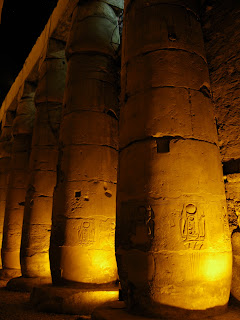Although we fly to Cairo at an ungodly hour tomorrow morning, we have yet to take a carriage ride around the streets of Luxor. Our hotel is on a back street, adjacent an outdoor cafe, and we have seen off duty carriages parked while their drivers partake of a coffee and play some sort of a board game. It is 9:30 P.M. when we wander over to a lone horse and carriage. A sports game of some sort is blaring on the small T.V. and the men at the cafe are absorbed with it. We speak with one man, disinterested and obviously not the driver of the carriage. We walk away, disappointed when moments later, Mohammad catches up with us, only too willing to forego the game on T.V. and make us his game for the evening. We negotiate a 30 minute carriage ride for $13.00 and try to pay him the money. He waves his hands and tells us “later, later!” We climb aboard the back seat and he maneuvers the carriage along the pot holed surface of the side street onto the main avenue that runs adjacent to the Nile River. The reassuring clip clop of the horses’ hooves upon the pavement is nostalgic and we relax into being the tourists that we are. We pass the Luxor Temple, aglow with lights, then veer down an urban throughway. Although it is nearly 10:00 P.M. the shops are still open and I wish that there had been a free afternoon to explore the city. Mohamed turns off of the main drag and within a few blocks we are maneuvering the narrow streets of the local market place. The small shops are packed full of merchandise. Shoes and kitchenware spill onto the street and colorful abayas are strung high across the narrow street. We trot past bakeries, fruit and vegetable stands, spice shops and tiny cafes. The pungent aroma from the food vendors fills the air. I take jiggly and blurred photos from our moving carriage, hoping to capture the energy and magic of the moment. My friend Stephanie is certified in traditional Chinese medicine and nutrition. The many herb and spice shops we pass are of interest to her and she asks Mohammed about them. Before long he stops the carriage, helps us down and escorts us into a tiny shop crammed floor to ceiling with jars and baskets of spices and herbs. I am unfamiliar with many of the items that Stephanie requests but I remember her asking for hibiscus flowers, saffron and vanilla. The merchant weighs out her various requests, sealing each item in a plastic bag, eventually disclosing the total of her bill. Although I am not knowledgeable about the value of these items, the price seems excessive and Stephanie negotiates a lesser amount. Everyone satisfied we return to the carriage, and I realize that we have been on this ride much longer than the 30 minutes that we negotiated. I assume that Mohammad will now take us directly back to our hotel, but he mentions food for the horse and we veer down another side street where there is a wagon laden with horse fodder. Mohammad loads 5 or 6 bales into the front of the carriage; feeds some to his horse and continues on. I sense that it must be past 11:00 P.M. and again assume that Mohammad is taking us back to our hotel, but we have made many twists and turns throughout the evening and I am disoriented. Recognizing some landmarks, I feel assured that we are heading back, but he makes another turn away from our hotel. We have told him several times that we need to get up early in the morning and I’m not sure if I say something, or just think it; but he asks if we are ready to go home. Within a few more turns we are back in front of our hotel and it is now time to pay up. It is 11:30 P.M. and we have been naive in believing that the drawn out carriage ride was simply time getting away from us all. We offer him what we believe is a generous amount; considerably more than what we agreed upon, but he rejects it; seemingly offended. He asks if we enjoyed the ride? We agree that evening has been delightful and ante up another $10.00. I don’t have change and he takes my bill; the equivalent of $20.00 and stuffs it into the pocket of his robe. He fusses with the horse, expecting that I will forget about the change due me, but I am insistent and eventually he hands me the change. Stephanie and I return to our hotel, exhausted and exhilarated from the evening. We have only a few hours to sleep before our flight to Cairo in the morning.












